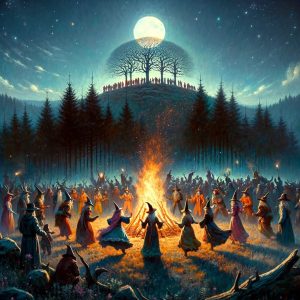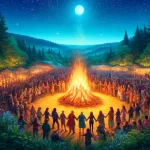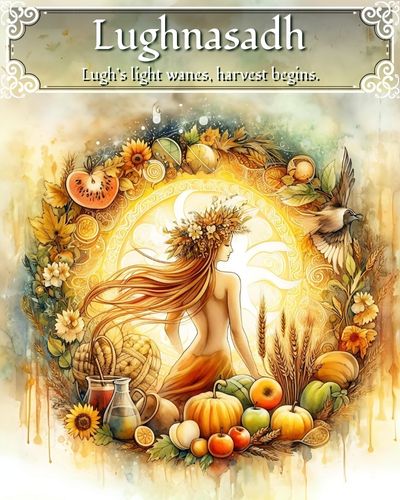
Approx. Reading time: About 13 Minutes

Introduction
Unlocking the Mysteries of the Winter Solstice
In the hushed whispers of December’s crisp winds, a celestial ballet takes center stage — the Winter Solstice, an astronomical masterpiece unveiling around December 21st. Beyond the clinical precision of its scientific definition lies a rich tapestry woven with the threads of antiquity, folklore, and an intimate connection to the pulsating rhythms of our Earth. As the night extends its shadowy embrace, the Winter Solstice emerges not just as a celestial event but as a profound intersection of science and spirituality, where ancient tales and cosmic phenomena entwine in a dance that transcends the boundaries of time. Join us on a journey into the heart of this celestial symphony, where the sky becomes a canvas painted with the echoes of centuries past, and the Earth aligns itself with the majestic rhythms of the cosmos.

Understanding the Solstice: Embracing the Cosmic Pause
The etymology of the term “solstice” unveils a linguistic ballet that gracefully describes a celestial spectacle. It emerges from the Latin roots “sol,” the radiant star that lights our days, and “sistere,” an invitation to stand still. Together, they craft a narrative of the Sun’s celestial ballet, a momentary pause in its grand journey.
As the Sun reaches the Tropic of Capricorn, this cosmic choreography unfolds. At the Winter Solstice, a mesmerizing interplay of celestial forces occurs, rendering the Sun’s noontime elevation seemingly motionless. The Sun, in its southernmost journey across the sky, hesitates, creating a pause that resonates across the fabric of the Earth’s seasons.
This cosmic stillness marks the official commencement of winter. In this ephemeral moment, the Earth lingers at the threshold of darkness, and daylight surrenders its temporal dominion to the extended reign of night. It is a delicate cosmic balance, a transition woven into the very fabric of nature’s rhythm.
This phenomenon, spanning cultures and epochs, carries profound symbolism. It is more than a mere shift in seasons; it is a promise—a celestial covenant of the Sun’s rebirth. As the Sun pauses in its southern sojourn, it whispers assurances of renewal and the eventual triumph of light over the encroaching darkness.
In this transient moment of stasis, the Winter Solstice becomes a cosmic junction, inviting contemplation and reflection. Across cultures, from ancient civilizations to contemporary societies, this celestial event is honored as a pivotal point in the dance of the cosmos. It symbolizes not only the changing seasons but also the cyclical nature of life, where even in the quiet stillness, the promise of a vibrant, sunlit future is silently held.
Journey through Shadows: Embracing the Celestial Ballet
As we stand at the threshold of the Winter Solstice, we embark on a profound journey through shadows—a celestial ballet that mirrors the ebb and flow of life’s eternal cycle. This pivotal point in the solar calendar marks a moment of celestial reckoning, where the sunlit tapestry of our days, gradually diminishing since the radiant glow of the summer solstice, begins to weave a new narrative.
Picture the cosmic stage: the sun, having completed its southern sojourn, lingers at the Tropic of Capricorn. The world, draped in shadows and the hushed whispers of the impending winter, awaits the celestial performance. In this grand spectacle, the dance of darkness and light unfolds with exquisite precision.
As we journey through the shadows of the Winter Solstice, the lengthening nights become a canvas on which nature paints its introspective masterpiece. It’s a dance where darkness yields not to an abyss but to the promise of a gentle, gradual return of the light. The world, cloaked in the quiet serenity of winter, prepares for the silent alchemy of renewal.
This celestial ballet is not merely a cosmic phenomenon but a profound reflection of life’s cyclical nature. It echoes the universal truth that every descent into darkness is a prelude to a triumphant ascent into light. The Winter Solstice becomes a celestial reminder that, even in the coldest and darkest of moments, the promise of renewal is quietly held in the cosmic embrace.
In the hush of winter’s shadowy contemplation, we find solace. It’s a time to reflect on our personal journeys, acknowledging the challenges and embracing the transformative power of resilience. The lengthening days post-solstice become a metaphorical roadmap, guiding us toward the renewal of spirit and the eventual blossoming of the world into spring.
As we traverse the cosmic dance floor, moving from the quietude of shadows to the burgeoning radiance of a sunlit future, the Winter Solstice invites us to partake in the grandeur of existence. It is a celestial proclamation that, even in the heart of winter’s embrace, the seeds of spring lie dormant, ready to awaken and usher in a new chapter in the eternal cosmic journey.
Global Celebrations and Traditions: A Tapestry of Winter’s Embrace
Venturing into the rich tapestry of global celebrations, the Winter Solstice emerges as a universal beacon, illuminating diverse cultures with its significance. Across continents and centuries, humanity has woven an intricate tale of reverence for nature, renewal, and the delicate interplay of light and shadow.
Stonehenge’s Solstice Symphony: An Ode to Earth’s Rhythms
In the heart of England, the Salisbury Plain cradles an ancient marvel — the enigmatic stones of Stonehenge. Steeped in mystery and cloaked in the mists of time, this sacred site transforms into a stage for a Druidic symphony during the Winter Solstice. As the world awaits the sun’s first light, a spectacle of profound symbolism unfolds.
As darkness clings to the night, the assembled crowd, wrapped in anticipation, witnesses a celestial alignment that transcends generations. The first rays of the newborn sun extend a golden embrace to Stonehenge’s weathered stones, casting shadows that dance in harmony with the ancient monoliths. The air is charged with a palpable energy, and amidst the whispers of history, a profound connection to the earth’s rhythms is forged.
Druidic traditions, with roots reaching back through the corridors of time, come alive in this sacred space. Each stone, weathered by centuries, becomes a sentinel bearing witness to the cyclical dance of the cosmos. The Winter Solstice is more than an astronomical event here; it is a living testament to the wisdom that the cycles of nature are the very threads weaving the fabric of our existence.
In this moment of alignment, the boundaries between past and present blur. The Druids, the ancient priestly class of the Celts, revered this celestial juncture as a sacred communion with the earth. Stonehenge, their sacred canvas, becomes a bridge across time, echoing with the footsteps of those who, in ages past, gathered to celebrate the changing seasons.
The stones, weathered yet enduring, stand as silent witnesses to countless solstices. They are not mere rocks; they are conduits of energy, resonating with the echoes of rituals performed by those who sought to understand and honor the mysteries of the cosmos. Each Winter Solstice, as the sun heralds a new cycle, Stonehenge becomes a living testament to the enduring connection between humanity and the celestial ballet above.
As the solstice sunbathes the stones in its gentle glow, a collective breath is drawn. The spectacle is more than a visual feast; it is a reminder that, in the dance of light and shadow, we find echoes of our own journey through the seasons of life. Stonehenge stands not just as an ancient monument but as a living, breathing testament to the profound harmony that exists when humanity acknowledges its place within the grand tapestry of the cosmos.
Dongzhi’s Dance of Yin and Yang: A Celestial Reunion
Embarking on an eastward journey, China unfolds its vibrant tapestry of tradition during the Dongzhi Winter Solstice Festival. As the world tilts towards the longest night, families gather not only for the warmth of shared company but to partake in a celestial dance of cosmic forces — the delicate interplay between yin and yang, darkness and light.
In the cosmic theater, Dongzhi stands as a spectacle of profound symbolism. It marks the zenith of yin forces, the moment when darkness claims its throne, shrouding the world in the quietude of winter. Yet, in this very embrace of darkness, there lies the promise of renewal, for the Winter Solstice is the tipping point where yin gracefully yields to yang — the positive, masculine energy that heralds the gradual return of light.
Families, wrapped in the warmth of tradition, gather to pay homage to this cosmic ballet. At the heart of the celebration are dumplings, not merely culinary delights but metaphors for the dance of celestial energies. Shaped like the crescent moon, these savory parcels become edible emblems of the universe’s cyclical rhythm. With each bite, families embrace the returning light, a tangible connection to the cosmic forces that govern the dance between day and night.
The significance of Dongzhi transcends the culinary, weaving into its fabric layers of cultural heritage and metaphysical understanding. It is a time for reflection, for acknowledging the ebb and flow of life’s energies, and for finding harmony within the cosmic symphony. Dongzhi, with its roots reaching deep into Chinese philosophy, invites a contemplative pause amid the hustle of modern life, urging individuals to attune themselves to the subtleties of the changing seasons.
As the dumplings steam and the fragrance of tradition wafts through homes, Dongzhi becomes more than a festival; it becomes a celestial reunion. Families, generations intertwined, savor not just the culinary craftsmanship but the essence of yin and yang, of darkness and the promise of returning light. In the tapestry of Dongzhi, China paints a portrait of cosmic harmony, inviting all to partake in the dance of celestial forces and find solace in the embrace of tradition.
Feast of Juul: A Hearth of Ancient Fires
In the heart of Scandinavia, where winter’s chill bites with particular fervor, the Feast of Juul emerges as a timeless celebration, echoing through the annals of history with the crackling warmth of fires that symbolize the Sun’s life-giving properties. It is a festival that not only kindles flames in the hearths but also ignites the spirit of community and the enduring connection between humanity and the cosmos.
At the heart of this Nordic jubilation is the venerable Yule log, a tangible link to ancient rites and a bearer of profound significance. Lit in honor of the mighty Scandinavian god Thor, whose thunderous chariot traversed the celestial expanse, the Yule log becomes more than a source of warmth; it transforms into a conduit between mortal realms and the divine. In the flickering dance of flames, the Norse people saw a reflection of Thor’s mighty power, a celestial symphony echoing through the winter night.
The Yule log, carefully chosen and ceremoniously ignited, becomes a focal point for communities to gather around. As its flames reach towards the heavens, the crackling embers carry with them the hopes, dreams, and aspirations of those who partake in this ancient ritual. It symbolizes not just the warmth of hearth and home but the enduring spirit of resilience against the winter’s cold embrace.
Yet, it is not merely in the act of burning that the Yule log finds its significance. Its unburned remnants, carefully preserved, are regarded as more than mere firewood. They are tokens of good fortune, holding the promise of protection against misfortune. This belief, etched in the cultural fabric of the Norse people, has echoed through centuries, and left an indelible mark on contemporary Yuletide traditions.
In modern times, as hearths are kindled and homes adorned with festive decorations, the spirit of the Feast of Juul lives on. The Yule log, whether in physical form or as a symbol, continues to bridge the gap between ancient traditions and present-day celebrations. It stands as a testament to the enduring power of rituals that connect us to our past, illuminate our present, and light the way for generations yet to come.
Saturnalia’s Grandeur: A Tapestry of Joy Across Time
In the mosaic of ancient Rome’s grandeur, the festival of Saturnalia emerged as a radiant gem, illuminating the darkest days of winter with the effulgence of merriment and revelry. This celestial juncture, marked by the Winter Solstice, became a time when the ordinary rules of life were cast aside, and the extraordinary took center stage.
At the heart of Saturnalia was the suspension of discipline and the joyful reversal of societal norms. The rigid structures of Roman life yielded to a carnival of freedom, where grudges were forgiven, and the echoes of war faded into the background. In this topsy-turvy realm, a spirit of communal joy reigned supreme, transcending the mundane concerns of everyday life.
The festival found its zenith on December 17 and extended its jubilant embrace for seven days, creating a temporal sanctuary where the usual order of things was turned on its head. Slaves became masters, and masters served their subordinates—a temporary liberation from the societal hierarchies that defined Roman life.
The echoes of Saturnalia, with its jubilant abandon and emphasis on communal harmony, resonate through the corridors of time and find a curious reflection in contemporary celebrations surrounding Christmas and the New Year. The suspension of hostilities, the forgiveness of grievances, and the collective embrace of joy during the festive season echo the essence of Saturnalia, reminding us that the ancient traditions of Rome continue to shape and enrich our modern festivities.
In the twinkling lights of holiday decorations and the warmth of shared gatherings, we catch glimpses of the Roman revelry that once graced the streets and homes of the ancient empire. Saturnalia, with its timeless message of unity, merriment, and the celebration of life’s joys, stands as a testament to the enduring influence of ancient customs on the tapestry of our contemporary celebrations.
As we traverse the globe, it becomes evident that the Winter Solstice is not merely an astronomical event but a global phenomenon that transcends cultural boundaries. It’s a testament to humanity’s shared connection to the cosmos, a reminder that, beneath the diversity of rituals and customs, we are united in our acknowledgment of nature’s cyclical dance—a dance where shadows yield to light, and the world, in its winter slumber, prepares for the promise of spring.
Light and Dark, Great Night and Warm Day
In the enchanted embrace of the Winter Solstice, the dance between light and darkness takes on profound symbolic significance for witches, Wiccans, and pagans alike. As the sun’s radiance wanes, and the night extends its tender grip, a tapestry of ancient symbolism unfolds, weaving together threads of spiritual introspection, renewal, and the unwavering hope for the returning sun.
For practitioners of the Craft, the lengthening night is not a descent into foreboding shadows but a sacred journey into the depths of the soul. It mirrors the introspective nature of the winter season, urging witches to turn inward, exploring the hidden recesses of their being. In the cloak of darkness, secrets are whispered, and the silent stirrings of the inner self are unveiled.
Yet, within this embrace of shadows lies the promise of renewal. The Winter Solstice marks the moment when the pendulum swings, when the darkness surrenders to the waxing light. It’s a time of spiritual metamorphosis, akin to the hibernation of nature. As the Earth slumbers beneath the frost-kissed mantle, so too does the practitioner find solace in a cocoon of self-discovery.
Across diverse pagan traditions, the returning sun is hailed as a symbol of hope and rebirth. The Oak King, dormant during the reign of the Holly King, awakens with the promise of burgeoning light. This cyclical battle between the kings mirrors the eternal dance of life and death, encouraging practitioners to reflect on the cyclical nature of their own existence.
Candles, those flickering beacons of illumination, become sacred tools during this celestial juncture. Lit in rituals and ceremonies, they represent the triumphant return of the sun’s vitality. The flame, resilient in the face of encroaching darkness, embodies the indomitable spirit that seeks illumination even in the bleakest of times.
As the Winter Solstice graces the sacred wheel, witches, Wiccans, and pagans find themselves cradled in the arms of ancient symbolism. The darkness becomes a canvas for profound spiritual revelations, and the burgeoning light becomes a beacon of hope, guiding the way through the enchanted tapestry of the winter night.
Crafting Magic in the Stillness of the Longest Night
In the mystical embrace of the Winter Solstice, practitioners of magic find themselves attuned to the subtle energies of this celestial dance. The solstice offers a unique opportunity to engage in magic that aligns with the themes of introspection, rebirth, and the interplay of light and shadow. Here’s a guide to the best magic to practice during this enchanting time:
Winter Altars: As the world slumbers beneath the frost-kissed blanket, your altar becomes a sacred space for reflecting the season’s energies. Adorn it with symbols of the Winter Solstice—evergreen branches, pinecones, and candles. Incorporate images of the returning sun, and perhaps a representation of the Oak King or other deities associated with the season.
Candle Magic: Candles, with their flickering flames, hold profound significance during the Winter Solstice. Engage in candle magic to symbolize the triumph of light over darkness. Use white candles for purity and renewal, gold for the returning sun’s vitality, and blue for spiritual introspection. As you light each candle, visualize the warmth and illumination infusing your magical workings.
Divination: The extended night of the Winter Solstice provides an ideal canvas for divination. Whether through tarot cards, scrying mirrors, or runes, seek insights into the coming season. The veil between worlds is thin, enhancing your intuitive connection to unseen realms.
Herbal Magic: Explore the magic of winter herbs and plants. Incorporate juniper, pine, or cedar into your rituals for their purifying properties. Brew teas with herbs like chamomile and lavender to foster a sense of calm and introspection. These herbal allies can enhance your magical intentions during the solstice.
Sun Deities: Honor deities associated with the sun, such as Apollo, Ra, or Sol. Offer gratitude for the returning light and seek their blessings for personal renewal and growth. Consider crafting invocations or prayers to these deities, acknowledging their influence on the cosmic dance unfolding during the Winter Solstice.
Oak King Rituals: In pagan traditions, the Oak King symbolizes the burgeoning light during the waxing half of the year. Craft rituals to honor the Oak King, expressing gratitude for his awakening presence. Consider creating a representation of the Oak King on your altar or engaging in a ceremonial battle between the Oak and Holly Kings.
As you immerse yourself in the magic of the Winter Solstice, let your intentions be guided by the energy of the season. Embrace the stillness of the longest night, for within it lies the fertile ground for magical transformation and the promise of the returning sun’s radiant embrace.
Conclusion
As the Northern Hemisphere embraces the longest night of the year, the Winter Solstice invites us to step into the realm of ancient rituals and timeless traditions. It’s a moment when nature itself seems to hold its breath, and the promise of lengthening days is whispered through the shadows. From the Druids honoring the Alban Arthan to the Scandinavians kindling the Yule log, and the Romans reveling in Saturnalia, the Winter Solstice transcends time and cultural boundaries. It’s a universal pause—a cosmic interlude—where humanity, throughout history, has found solace in the darkness, celebrating the triumph of light. As you witness your lengthening noontime shadow during this season, remember that it echoes an age-old dance between Earth and Sun. The Winter Solstice is not merely an astronomical event but a profound tapestry of human connection with the cosmos, a celebration of renewal amidst the quietude of winter’s embrace.













